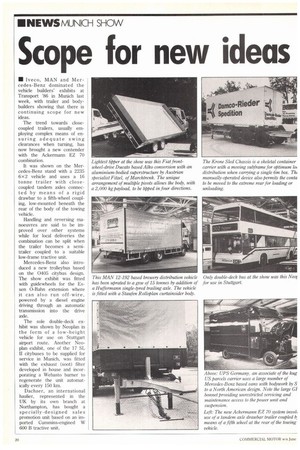Scope for new ideas
Page 20

Page 21

If you've noticed an error in this article please click here to report it so we can fix it.
• Iveco, MAN and Mercedes-Benz dominated the vehicle builders' exhibits at Transport '86 in Munich last week, with trailer and bodybuilders showing that there is continuing scope for new ideas.
The trend towards closecoupled trailers, usually employing complex means of ensuring adequate swing clearances when turning, has now brought a new contender with the Ackermann EZ 70 combination.
It was shown on the Mercedes-Benz stand with a 2235 6x2 vehicle and uses a 16 tonne trailer with closecoupled tandem axles connected by means of a rigid drawbar to a fifth-wheel coupling, low-mounted beneath the rear of the body of the towing vehicle.
Handling and reversing manoeuvres are said to be improved over other systems while for local deliveries the combination can be split when the trailer becomes a semitrailer coupled to a suitable low-frame tractive unit.
Mercedes-Benz also introduced a new trolleybus based on the 0405 citybus design. The show exhibit was fitted with guidewheels for the Essen O-Bahn extension where it can also run off-wire, powered by a diesel engine driving through an automatic transmission into the drive axle.
The sole double-deck exhibit was shown by Neoplan in the form of a low-height vehicle for use on Stuttgart airport route. Another Neoplan exhibit, one of the 17 SL II citybuses to be supplied for service in Munich, was fitted with the exhaust (soot) filter developed in house and incorporating a Webasto burner to regenerate the unit automatically every 150 km.
Dachaer, an international haulier, represented in the UK by its own branch at Northampton, has bought a specially-designed sales promotion unit based on an imported Cummins-engined W 600 B tractive unit.
What is happening to the at British ambulance? Judgby the numbers of im.ed chassis at last week's 3ex ambulance show at rogate, it could be in ;er of going the same way le British heavy truck in Seventies,
f the 35 ambulances on 17 were based on ign chassis. While all the building work is still carout in the UK and Ire, Continental chassis ufacturers — particularly Renault — are increasing their market share with ambulance conversions based on large panel vans.
Panel vans now account for 20% of all front-line sales, and are proving increasingly more attractive compared with traditional GRP-bodied chassis cabs.
Most front-line ambulances in operation are British, but how long will this last?
Freight Rover's recentlylaunched 98kW (132 hp) Sherpa V8 is, at least, picking up some of the sales created by the demise of the old Transit V6 chassis cab — previously the most popular ambulance chassis in the frontline market.
The new Transit V6 is not expected to be available for ambulance conversions until the autumn.
However, with interest growing in fitting smaller, turbocharged engines, including more fuel-efficient diesels, in front-line ambulances, the days of the high-displacement petrol engine may be numbered. With turbocharging, the importers are clearly leading the way.
Only 1,000 front-line ambulances sold last year, so some UK manufacturers may consider the market insignificant despite its obvious prestige.
But slightly more worrying were the claims from a number of Ambex visitors that the importers appear to be more interested in their business. A case of deja vu perhaps?
















































































